In the summer of 2018, we’re launching Parker Solar Probe, a spacecraft that will get closer to the Sun than any other in human history.

Parker Solar Probe will fly directly through the Sun’s atmosphere, called the corona. Getting better measurements of this region is key to understanding our Sun. For instance, the Sun releases a constant outflow of solar material, called the solar wind. We think the corona is where this solar wind is accelerated out into the solar system, and Parker Solar Probe’s measurements should help us pinpoint how that happens.

The solar wind, along with other changing conditions on the Sun and in space, can affect Earth and are collectively known as space weather. Space weather can trigger auroras, create problems with satellites, cause power outages (in extreme cases), and disrupt our communications signals. That’s because space weather interacts with Earth’s upper atmosphere, where signals like radio and GPS travel from place to place.

Parker Solar Probe is named after pioneering physicist Gene Parker. In the 1950s, Parker proposed a number of concepts about how stars — including our Sun — give off energy. He called this cascade of energy the solar wind. Parker also theorized an explanation for the superheated solar atmosphere, the corona, which is hotter than the surface of the Sun itself.

Getting the answers to our questions about the solar wind and the Sun’s energetic particles is only possible by sending a probe right into the furnace of the Sun’s corona, where the spacecraft can reach 2,500 degrees Fahrenheit. Parker Solar Probe and its four suites of instruments – studying magnetic and electric fields, energetic particles, and the solar wind – will be protected from the Sun’s enormous heat by a 4.5-inch-thick carbon-composite heat shield.
Over the course of its seven-year mission, Parker Solar Probe will make two dozen close approaches to the Sun, continuously breaking its own records and sending back unprecedented science data.

Getting close to the Sun is harder than you might think, since the inertia of a spacecraft launched from Earth will naturally carry it in repeated orbits on roughly the same path. To nudge the orbit closer to the Sun on successive trips, Parker Solar Probe will use Venus’ gravity.
This is a technique called a gravity assist, and it’s been used by Voyager, Cassini, and OSIRIS-REx, among other missions. Though most missions use gravity assists to speed up, Parker Solar Probe is using Venus’ gravity to slow down. This will let the spacecraft fall deeper into the Sun’s gravity and get closer to our star than any other spacecraft in human history.

You can get a behind-the-scenes at Parker Solar Probe under construction in a clean room at facebook.com/NASASunScience today (Sept. 25) at 1:45 PM EDT.

+++
Media Invited to View NASA Spacecraft That Will Touch Our Sun

NASA’s Parker Solar Probe will be humanity’s first-ever mission to explore the Sun’s outer atmosphere. Media are invited to see the spacecraft and learn about the mission from noon to 2 p.m. EDT Monday, Sept. 25, at Johns Hopkins University Applied Physics Laboratory (APL) in Laurel, Maryland, where the probe is being built.
The spacecraft will be in full flight configuration, complete with its revolutionary heat shield, and members of the engineering and science teams conducting this historical mission will be available for interviews.
Media who would like to attend must register with APL by sending an email with name, affiliation and cell phone number to aplpublicaffairs@jhuapl.edu no later than 5 p.m. on Friday, Sept. 22. Instructions on attendance will be provided upon registration.
Due to facility limitations, the number of participants is limited, and the event is open only to U.S. citizens. The event will take place in a clean room. Attendees should allow additional time for cleaning of cameras and equipment by APL staff.
The spacecraft, about the size of a small car, will launch in mid-summer 2018. It will travel directly through the Sun's atmosphere about four million miles from our star's surface – facing heat and radiation unlike any spacecraft in history – and make critical observations to answer decades-old questions about how stars work. Mission data ultimately will improve forecasts of major space weather events that affect life on Earth, as well as satellites and astronauts in space.
+++
Parker Solar Probe: Humanity’s First Visit to a Star
NASA's historic Parker Solar Probe mission will revolutionize our understanding of the sun, where changing conditions can propagate out into the solar system, affecting Earth and other worlds. Parker Solar Probe will travel through the sun’s atmosphere, closer to the surface than any spacecraft before it, facing brutal heat and radiation conditions — and ultimately providing humanity with the closest-ever observations of a star.
Journey to the Sun
- Launch Window: July 31 – Aug. 19, 2018
- Launch Site: NASA's Kennedy Space Center, Florida
- Launch Vehicle: Delta IV-Heavy with Upper Stage
In order to unlock the mysteries of the sun's atmosphere, Parker Solar Probe will use Venus’ gravity during seven flybys over nearly seven years to gradually bring its orbit closer to the sun. The spacecraft will fly through the sun’s atmosphere as close as 3.9 million miles to our star’s surface, well within the orbit of Mercury and more than seven times closer than any spacecraft has come before. (Earth’s average distance to the sun is 93 million miles.)
Flying into the outermost part of the sun's atmosphere, known as the corona, for the first time, Parker Solar Probe will employ a combination of in situ measurements and imaging to revolutionize our understanding of the corona and expand our knowledge of the origin and evolution of the solar wind. It will also make critical contributions to our ability to forecast changes in Earth's space environment that affect life and technology on Earth.
Extreme Exploration
At closest approach, Parker Solar Probe hurtles around the sun at approximately 430,000 mph (700,000 kph). That's fast enough to get from Philadelphia to Washington, D.C., in one second.
At closest approach to the sun, the front of Parker Solar Probe's solar shield faces temperatures approaching 2,500 F (1,377 C). The spacecraft's payload will be near room temperature.
On the final three orbits, Parker Solar Probe flies to within 3.7 million miles of the sun's surface – more than seven times closer than the current record-holder for a close solar pass, the Helios 2 spacecraft, which came within 27 million miles in 1976 and more than 10 times closer than Mercury, which is about 42 million miles from the sun.
Parker Solar Probe will perform its scientific investigations in a hazardous region of intense heat and solar radiation. The spacecraft will fly close enough to the sun to watch the solar wind speed up from subsonic to supersonic, and it will fly though the birthplace of the highest-energy solar particles.
To perform these unprecedented investigations, the spacecraft and instruments will be protected from the sun’s heat by a 4.5-inch-thick (11.43 cm) carbon-composite shield, which will need to withstand temperatures outside the spacecraft that reach nearly 2,500 F (1,377 C).
The Science of the Sun
The primary science goals for the mission are to trace how energy and heat move through the solar corona and to explore what accelerates the solar wind as well as solar energetic particles. Scientists have sought these answers for more than 60 years, but the investigation requires sending a probe right through the 2,500 degrees Fahrenheit heat of the corona. Today, this is finally possible with cutting-edge thermal engineering advances that can protect the mission on its dangerous journey. Parker Solar Probe will carry four instrument suites designed to study magnetic fields, plasma and energetic particles, and image the solar wind.
Teaming for Success
Parker Solar Probe is part of NASA’s Living With a Star program to explore aspects of the sun-Earth system that directly affect life and society. The Living With a Star flight program is managed by the agency’s Goddard Space Flight Center in Greenbelt, Maryland, for NASA’s Science Mission Directorate in Washington. The Johns Hopkins University Applied Physics Laboratory in Laurel, Maryland, manages the mission for NASA. APL is designing and building the spacecraft and will also operate it.
Why do we study the sun and the solar wind?
- The sun is the only star we can study up close. By studying this star we live with, we learn more about stars throughout the universe.
- The sun is a source of light and heat for life on Earth. The more we know about it, the more we can understand how life on Earth developed.
- The sun also affects Earth in less familiar ways. It is the source of the solar wind; a flow of ionized gases from the sun that streams past Earth at speeds of more than 500 km per second (a million miles per hour).
- Disturbances in the solar wind shake Earth's magnetic field and pump energy into the radiation belts, part of a set of changes in near-Earth space known as space weather.
- Space weather can change the orbits of satellites, shorten their lifetimes, or interfere with onboard electronics. The more we learn about what causes space weather – and how to predict it – the more we can protect the satellites we depend on.
- The solar wind also fills up much of the solar system, dominating the space environment far past Earth. As we send spacecraft and astronauts further and further from home, we must understand this space environment just as early seafarers needed to understand the ocean.
Quelle: NASA
---
Update: 9.11.2017
.
On Monday, Nov. 6, 2017, NASA's Parker Solar Probe spacecraft arrived at NASA’s Goddard Space Flight Center in Greenbelt, Maryland, for environmental tests. During the spacecraft’s stay at Goddard, engineers and technicians will simulate extreme temperatures and other physical stresses that the spacecraft will be subjected to during its historic mission to the Sun.
Before arriving at Goddard, Parker Solar Probe was at the Johns Hopkins University Applied Physics Laboratory in Laurel, Maryland, where it was designed and built.
NASA’s Parker Solar Probe is scheduled for launch on July 31, 2018, from Cape Canaveral Air Force Station, Florida. The spacecraft will explore the Sun’s outer atmosphere and make critical observations that will answer decades-old questions about the physics of stars. The resulting data will also help improve how we forecast major eruptions on the Sun and subsequent space weather events that can impact life on Earth, as well as satellites and astronauts in space.
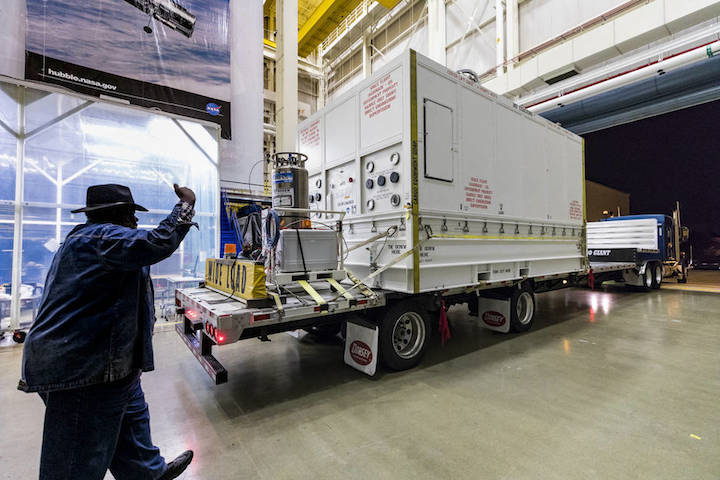



Watch Purple Lasers Light Up NASA's Parker Solar Probe in Test
NASA's Parker Solar Probe — which will fly closer to the sun than any spacecraft in history — recently passed an important prelaunch test of its solar panels with flying colors. Well, one color, in particular: Researchers used purple lasers at NASA's Goddard Space Flight Center to examine the probe.
Coincidentally, the purple hue of the lasers recalls Pantone's 2018 Color of the Year, a regal hue dubbed Ultra Violet by the Pantone Color Institute. Aptly enough, the company's executive director, Leatrice Eiseman, said in a statement that the color "suggests the mysteries of the cosmos, the intrigue of what lies ahead and the discoveries beyond where we are now."

Credit: NASA/Johns Hopkins APL/Ed Whitman
-
Aimed at the spacecraft's solar array, the purple lasers helped researchers verify that the 44 strings of solar cells on each panel are still electrically connected, following vibration and acoustic testing conducted earlier this fall, according to a statement from NASA. The vigorous noise and shaking helped simulate launch conditions that the probe will undergo when it takes off from Cape Canaveral Air Force Station in Florida on July 31, 2018.
The spacecraft will study the ejections of material and light that create "solar weather," and help scientists better understand some of the mysteries of our nearest star, such as why its atmosphere is hotter than its surface.
Critically, the panels will provide the power for the probe's sojourn in space. The laser testing was completed the week of Nov. 27, led by engineers at the Johns Hopkins Applied Physics Lab in Maryland, which is constructing the spacecraft and will operate it during its mission.
These tests use lasers because their tight beams allow the illumination of a single string of solar cells at a time, according to the statement. The color of a laser beam is determined by the wavelength of light that composes it. The engineers happened to have purple lasers readily available, and the solar cells operate efficiently at that wavelength, according to the statement.
The test also employed infrared lasers, which are invisible to the human eye.
Quelle: SC
---
Update: 6.03.2018
.
Want to get the hottest ticket this summer without standing in line?
NASA is inviting people around the world to submit their names online to be placed on a microchip aboard NASA’s historic Parker Solar Probe mission launching in summer 2018. The mission will travel through the Sun’s atmosphere, facing brutal heat and radiation conditions — and your name will go along for the ride.
“This probe will journey to a region humanity has never explored before,” said Thomas Zurbuchen, the associate administrator for the Science Mission Directorate at NASA Headquarters in Washington. “This mission will answer questions scientists have sought to uncover for more than six decades.”
Understanding the Sun has always been a top priority for space scientists. Studying how the Sun affects space and the space environment of planets is the field known as heliophysics. The field is not only vital to understanding Earth’s most important and life-sustaining star, it supports exploration in the solar system and beyond.
Submissions will be accepted until April 27, 2018. Learn more and add your name to the mission here: http://go.nasa.gov/HotTicket
The spacecraft, about the size of a small car, will travel directly into the Sun's atmosphere about 4 million miles from the star's surface. The primary science goals for the mission are to trace how energy and heat move through the solar corona and to explore what accelerates the solar wind as well as solar energetic particles. The mission will revolutionize our understanding of the Sun, where changing conditions can spread out into the solar system, affecting Earth and other worlds.
To perform these unprecedented investigations, the spacecraft and instruments will be protected from the Sun’s heat by a 4.5-inch-thick carbon-composite shield, which will need to withstand temperatures outside the spacecraft that reach nearly 2,500 F. This state-of-the-art heat shield will keep the four instrument suites designed to study magnetic fields, plasma and energetic particles, and image the solar wind at room temperature.
The spacecraft speed is so fast, at its closest approach it will be going at approximately 430,000 mph. That's fast enough to get from Washington, D.C., to Tokyo in under a minute.
“Parker Solar Probe is, quite literally, the fastest, hottest — and, to me, coolest — mission under the Sun,” said project scientist Nicola Fox, of the Johns Hopkins Applied Physics Laboratory. “This incredible spacecraft is going to reveal so much about our star and how it works that we’ve not been able to understand.”
Honoring a Science Legend
In May 2017, NASA renamed the spacecraft from the Solar Probe Plus to the Parker Solar Probe in honor of astrophysicist Eugene Parker. The announcement was made at a ceremony at the University of Chicago, where Parker serves as the S. Chandrasekhar Distinguished Service Professor Emeritus, Department of Astronomy and Astrophysics.
This was the first time NASA named a spacecraft for a living individual.
NASA missions are most often renamed after launch and certification. In this case, given Parker’s accomplishments within the field, and how closely aligned this mission is with his research, the decision was made to honor him prior to launch, in order to draw attention to his important contributions to heliophysics and space science.
In the 1950s, Parker proposed a number of concepts about how stars — including our Sun — give off energy. He called this cascade of energy the solar wind, and he described an entire complex system of plasmas, magnetic fields and energetic particles that make up this phenomenon. Parker also theorized an explanation for the superheated solar atmosphere, the corona, which is — contrary to what was expected by physics laws — hotter than the surface of the Sun itself. Many NASA missions have continued to focus on this complex space environment defined by our star.
Parker Solar Probe is part of NASA’s Living with a Star Program, or LWS, to explore aspects of the Sun-Earth system that directly affect life and society. LWS is managed by the NASA’s Goddard Space Flight Center in Greenbelt, Maryland, for NASA’s Science Mission Directorate in Washington. The Johns Hopkins Applied Physics Laboratory, in Laurel, Maryland, manages the Parker Solar Probe mission for NASA. APL is designing and building the spacecraft and will also operate it.
SXSW 2018: How NASA's Parker Solar Probe Was Engineered to Take the Heat
Breakthrough thermal shielding tech will let delicate electronics survive the brutal heat of the sun's corona
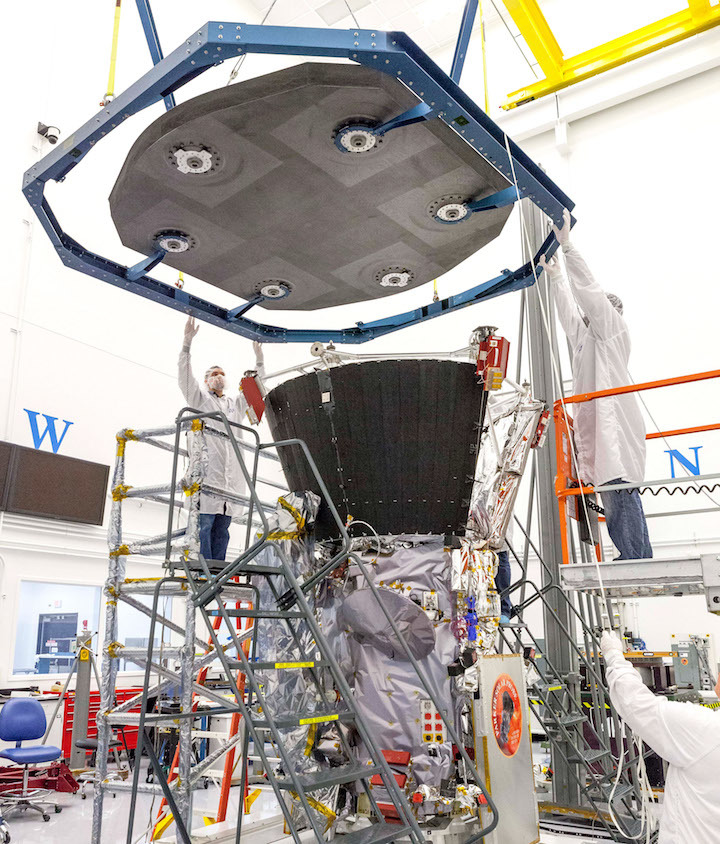
Over six decades of exploring the solar system, the U.S. National Aeronautics and Space Administration (NASA) has sent spacecraft to all of the planets, a smattering of moons, and even an asteroid or two. But the biggest hotspot of all—the sun—has remained unvisited. If all goes well, though, the sun will get its first emissary from Earth by the end of October.
The spacecraft, called the Parker Solar Probe, is now undergoing tests at NASA’s Goddard Space Flight Center in Greenbelt, Md. It’s the culmination of six decades of studies, tests, engineering and mission planning, dating back nearly to the founding of NASA itself, says Nicola Fox, the mission’s Project Scientist at the Johns Hopkins University Applied Physics Laboratory. Speaking at the 2018 South by Southwest Interactive conference in Austin, Texas, Fox called the ambitious project “the coolest hottest mission under the sun.”
Space scientists first proposed a visit to the sun in 1958, Fox adds. That year, James Van Allen (yes, that Van Allen) was part of a committee that proposed 12 missions to be undertaken by the newly-formed NASA. “Of the 12, 11 have already flown,” Fox notes. “The only one that did not was this probe [meant] to go up into the sun’s atmosphere,” Fox adds.
Fox explains that the probe is designed to help solve two deep mysteries about the sun. First, “Why is the corona”—the outer layer of the sun’s atmosphere—“hotter than the surface of the sun?” The surface has a temperature of 6000 degrees Centigrade, but the corona is roughly 300 times as hot, at about 3 million degrees.
“It doesn’t make sense,” Fox declares. “It’s like walking away from a campfire and it gets hotter as you move away.”
The other big question is: “What causes the material [in the outer layers of the Sun] to get so energized and actually cause the solar wind?” she adds. The solar wind, a continuous stream of charged particles (notably electrons and protons) that flow out of the sun into space, is the main mechanism by which the sun interacts magnetically with the Earth.
The most spectacular examples are the geomagnetic storms caused on Earth by solar-wind shock waves. The most powerful of these in recorded history was the 1859 Carrington event, which shut down all telegraph activity in the United States for four days and produced auroras so bright that some people and birds mistook the light for the rising sun. Various analyses have suggested that if a Carrington-type event were to happen now, it could cause US $2 trillion in damages and result in power outages that could last as long as a year.
To gain a better understanding of the solar wind, “at some point you have to go and visit,” Fox says. “You have to experience the environment. You have to measure [from inside] the corona—all the particles there: the ions, electrons, protons, the different particles and species, that are causing this huge flow.”
“It’s the last piece of the puzzle,” says Elizabeth Congdon, senior staff member at the Hopkins lab. Noting that the solar wind comes from the corona, she explains, “That’s where the magic happens. That’s where the solar wind is born. When we can put that piece into the models, we can do a dramatically better job of knowing how it will affect the Earth.”
“We’re going to be rewriting textbooks on solar science,” Congdon concludes.
The earliest launch window for the 12-week journey to the sun via Venus—which will bend the probe’s trajectory away from Earth orbit and toward its destination—begins on 31 July. Once in orbit around the sun, the probe’s closest approach will be 6.3 million kilometers (3.9 million miles) from the solar surface. Its orbital velocity will approach 690 000 kilometers/hour.
Among the many extreme tech challenges, dealing with the heat was foremost. The probe’s instruments—many of them magnetometers for measuring aspects of the solar wind—will be protected behind a roughly circular heat shield.
The heat shield consists of a layer of carbon foam sandwiched between two layers of a carbon composite, explains Congdon, whose official title is lead engineer for thermal protection systems. The 73-kilogram shield is 2.44 meters in diameter and a scant 11.43 centimeters (4.5 inches) thick. While the probe orbits the sun, the front of the heat shield is expected to reach 1400 degrees Centigrade; its back side will be a comparatively frosty 300 °C (600 °F). Inside the spacecraft’s bus, where the instruments will be shielded, the temperature is expected to be 30 °C (85 °F).
Photovoltaic cells, cooled by a heat-exchange system that uses water as the working fluid, will provide electric power on the craft. The team actually considered many different cooling fluids before settling on water, which had the best combination of characteristics, Congdon explains.
Another tech advance was the software that will give the probe enough autonomy to ensure that its heat shield is always between the sun and its instruments. Because it takes 8 minutes for radio waves to reach the sun, remote control of the craft was out of the question.
Fox explains that the long gestation period for the Parker mission was dictated by the pace of technological advances in fields such as materials science and software algorithms. “We had to wait 60 years for technology to catch up to our dreams,” she says.
“It’s been said that scientists see the world as it is and engineers see the world as it could be,” she adds. “This mission is about scientists and engineers working together."
Quelle: IEEE
---
Update: 22.03.2018
.
Media Invited to View NASA Spacecraft That Will Touch the Sun
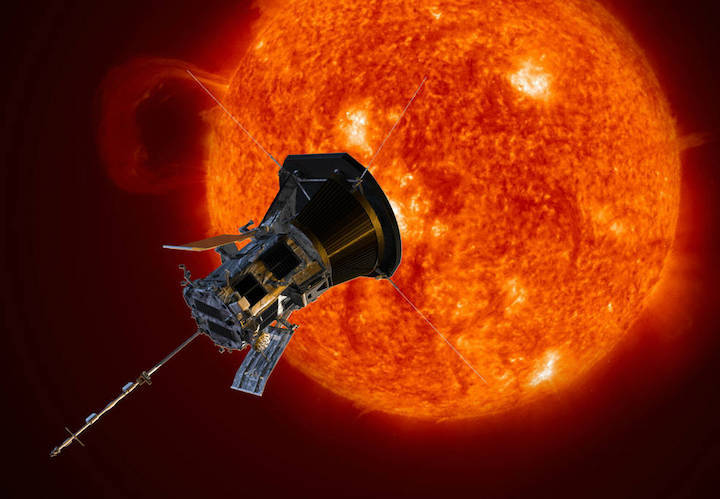
Media are invited to view NASA’s Parker Solar Probe spacecraft at 9:30 a.m. EDT on Wednesday, March 28, at the agency’s Goddard Space Flight Center in Greenbelt, Maryland. The spacecraft will embark this summer on a daring trek, traveling closer to the Sun than any spacecraft in history.
The Sun is the only star that can be studied up close. In addition to helping solve how stars throughout the universe drive heat, radiation, energy and particles out into space, data from the spacecraft will help scientists better understand how this constant solar outpouring can create hazardous space weather events near Earth. Space weather can impact not only astronauts living and working in space, but also interfere with satellites and radio signals.
Media attending the event will have an opportunity to interview the mission team as well as view the spacecraft from outside the cleanroom where it is undergoing final testing before it ships to NASA’s Kennedy Space Flight Center in Florida for a scheduled July 31 launch.
Quelle: NASA
---
Update: 7.04.2018
.
NASA’s Parker Solar Probe has arrived in Florida to begin final preparations for its launch to the Sun, scheduled for July 31, 2018.
In the middle of the night on April 2, the spacecraft was driven from NASA’s Goddard Space Flight Center in Greenbelt, Maryland, to nearby Joint Base Andrews in Maryland. From there, it was flown by the United States Air Force’s 436th Airlift Wing to Space Coast Regional Airport in Titusville, Florida, where it arrived at 10:40 a.m. EDT. It was then transported a short distance to Astrotech Space Operations, also in Titusville, where it will continue testing, and eventually undergo final assembly and mating to the third stage of the Delta IV Heavy launch vehicle.
Parker Solar Probe is humanity’s first mission to the Sun. After launch, it will orbit directly through the solar atmosphere – the corona – closer to the surface than any human-made object has ever gone. While facing brutal heat and radiation, the mission will reveal fundamental science behind what drives the solar wind, the constant outpouring of material from the Sun that shapes planetary atmospheres and affects space weather near Earth.
“Parker Solar Probe and the team received a smooth ride from the Air Force C-17 crew from the 436th,” said Andy Driesman, Parker Solar Probe project manager from the Johns Hopkins Applied Physics Laboratory in Laurel, Maryland. “This is the second most important flight Parker Solar Probe will make, and we’re excited to be safely in Florida and continuing pre-launch work on the spacecraft.”
At Astrotech, Parker Solar Probe was taken to a clean room and removed from its protective shipping container on Wednesday, April 4. The spacecraft then began a series of tests to verify that it had safely made the journey to Florida. For the next several months, the spacecraft will undergo comprehensive testing; just prior to being fueled, one of the most critical elements of the spacecraft, the thermal protection system (TPS), or heat shield, will be installed. The TPS is the breakthrough technology that will allow Parker Solar Probe to survive the temperatures in the Sun’s corona, just 3.8 million miles from the surface of our star.
“There are many milestones to come for Parker Solar Probe and the amazing team of men and women who have worked so diligently to make this mission a reality,” said Driesman. “The installation of the TPS will be our final major step before encapsulation and integration onto the launch vehicle.”
Parker Solar Probe will be launched from Launch Complex-37 at NASA’s Kennedy Space Center, Florida. The two-hour launch window opens at approximately 4 a.m. EDT on July 31, 2018, and is repeated each day (at slightly earlier times) through Aug. 19.
Throughout its seven-year mission, Parker Solar Probe will explore the Sun's outer atmosphere and make critical observations to answer decades-old questions about the physics of stars. Its data will also be useful in improving forecasts of major eruptions on the Sun and the subsequent space weather events that impact technology on Earth, as well as satellites and astronauts in space. The mission is named for University of Chicago Professor Emeritus Eugene N. Parker, whose profound insights into solar physics and processes have guided the discipline. It is the first NASA mission named for a living individual.
Parker Solar Probe is part of NASA’s Living With a Star Program to explore aspects of the connected Sun-Earth system that directly affect life and society. Living With a Star is managed by the agency’s Goddard Space Flight Center in Greenbelt, Maryland, for NASA’s Science Mission Directorate in Washington. Johns Hopkins APL designed, built and manages the mission for NASA. Instrument teams are led by researchers from the University of California, Berkeley; the University of Michigan in Ann Arbor; Naval Research Laboratory in Washington, D.C.; Princeton University in New Jersey; and the Smithsonian Astrophysics Observatory in Cambridge, Massachusetts.
United Launch Alliance of Centennial, Colorado, is the provider of the Delta IV launch service for Parker Solar Probe. NASA’s Launch Services Program (LSP), based at Kennedy Space Center in Florida, manages the agency’s efforts to commercially provide rockets for specific missions. LSP also directs the overall launch effort including overseeing development and integration of the rocket with the spacecraft.
Quelle: NASA
---
Update: 16.05.2018
.
DELTA IV HEAVY TO LAUNCH PARKER SOLAR PROBE
• Rocket: Delta IV Heavy
• Mission: Parker Solar Probe
• Launch Date: No earlier than Tuesday, July 31, 2018
• Launch Broadcast: Details to come
• Launch Location: Space Launch Complex-37, Cape Canaveral Air Force Station, Florida
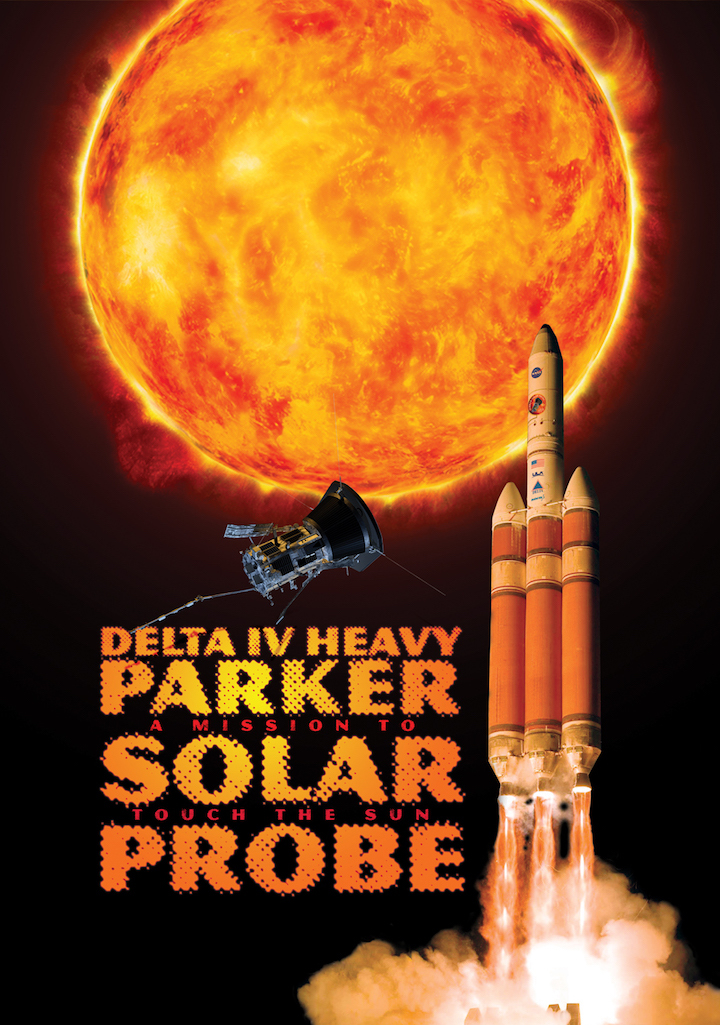
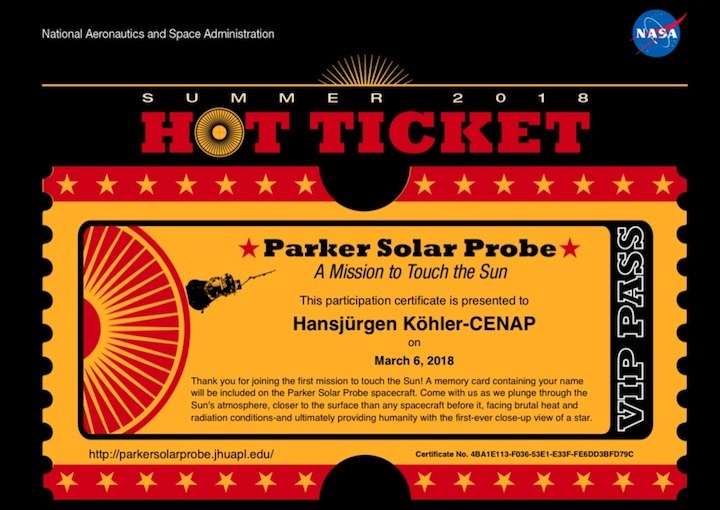
Mission Information: Parker Solar Probe is humanity’s first mission to the sun. After launch, it will orbit directly through the solar atmosphere – the corona – closer to the surface than any human-made object has ever gone. While facing brutal heat and radiation, the mission will reveal fundamental science behind what drives the solar wind, the constant outpouring of material from the sun that shapes planetary atmospheres and affects space weather near Earth.
Parker Solar Probe is part of NASA’s Living With a Star Program to explore aspects of the connected sun-Earth system that directly affect life and society.
Launch Notes: Parker Solar Probe is expected to break the record for the fastest spacecraft to leave Earth’s atmosphere, a record set by the New Horizons mission during launch on an Atlas V in 2006. Due to the extremely high energy required for this mission, the Delta IV Heavy’s capability will be augmented by a powerful third stage provided by Orbital ATK.
Go Delta! Go Parker Solar Probe!
Quelle: ULA
---
Update: 17.06.2018
.
Revised Launch Date Targeted for Parker Solar Probe
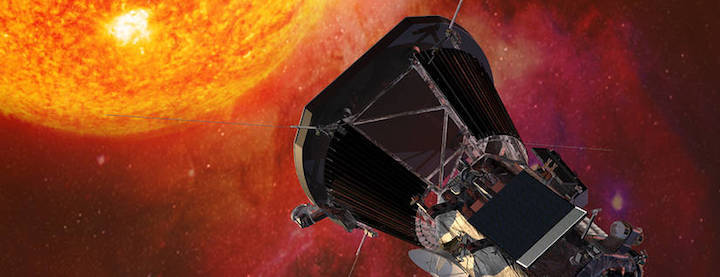
NASA and the Johns Hopkins University Applied Physics Laboratory are now targeting launch of the agency’s Parker Solar Probe spacecraft no earlier than Aug. 4, 2018. Originally scheduled to launch on July 31, additional time is needed to accommodate further software testing of spacecraft systems. The Parker Solar Probe will launch on a United Launch Alliance Delta IV Heavy rocket from Space Launch Complex 37 on Cape Canaveral Air Force Station in Florida.
Parker Solar Probe will fly closer to the Sun’s surface than any spacecraft before it, facing brutal heat and radiation conditions and ultimately providing humanity with the first-ever samplings of a star’s corona.
Quelle: NASA
---
Update: 19.06.2018
.
NASA refines date for high-profile Delta IV Heavy launch with Parker Solar Probe
A high-profile solar probe's launch from Cape Canaveral on United Launch Alliance's most powerful rocket is now slated for August as teams refine the mission's timeline.
NASA's Parker Solar Probe, originally scheduled to launch July 31, has been rescheduled for an Aug. 4 debut on a three-core Delta IV Heavy rocket from Launch Complex 37. An exact liftoff time is still being determined, but a roughly two-hour window should open around 4 a.m. that Saturday morning, according to NASA.
The agency over the weekend said teams need more time to test the 8-foot-wide, 1,500-pound robotic spacecraft's systems before its task takes it closer to the sun than any before it.
The mission: Approach to within a few million miles of the sun, survive the intense heat and radiation, and secure first-ever data samples from the corona, or the star's gaseous outer atmosphere. NASA says the probe, named after physicist Eugene Parker, will provide "our best chance yet at uncovering the complexities of solar activity in our own solar system and shedding light on the very nature of space and stars throughout the universe."
[SpaceX to launch most of its Starlink internet constellation from Cape Canaveral]
Ultimately, scientists hope data from the probe will expose behaviors of space weather and how our G-type main-sequence star, also known as a yellow dwarf, affects it.
Parker Solar Probe will end a two-year gap in Delta IV Heavy launches, which are the most powerful rockets in ULA's fleet as the company looks forward to its upcoming Vulcan rocket system. A second launch for the rocket from California is planned for the fall with a secretive payload for the National Reconnaissance Office, according to the Air Force.
Also this fall, SpaceX is expected to launch its next Falcon Heavy rocket from Kennedy Space Center's pad 39A with an Air Force mission designed to carry more than two dozen spacecraft, including NASA payloads, to different orbits. The latest schedules point to that occurring no earlier than October.
Contact Emre Kelly at aekelly@floridatoday.com or 321-242-3715. Follow him on Twitter and Facebook at @EmreKelly.
Have you tried 321 LAUNCH?
Thanks to cutting-edge augmented reality technology, or the overlaying of digital objects onto the real world made possible by mobile cameras, spaceflight now fits in your pocket. Explore launch pads, rockets and live launches in detail right on your smartphone.
Find the free 321 LAUNCH app in Apple's App Store or in Google Play for Android devices.
Version 1.1 of the app now supports United Launch Alliance's Atlas V rocket in all of its configurations. If you already have the app, be sure to update it to the latest version.
System requirements list:
Apple: iPhone 6S or newer; fifth-generation iPad (2017) or newer. All require iOS 11 and later.
Android's AR capabilities are limited to specific models running 7.0 Nougat and later.
Quelle: Florida Today








